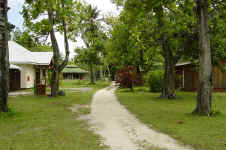
On
the left, the dive center
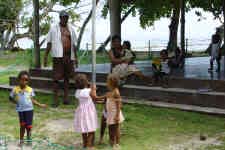
James
and Gemma in the day-care
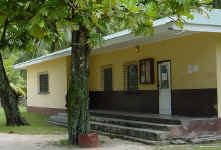
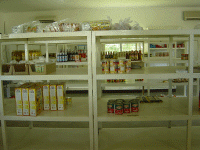
The
shop
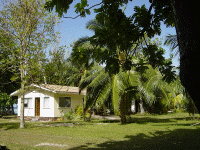
The
hospital
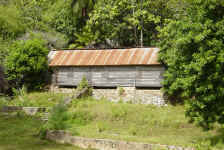
The hospital till 1984
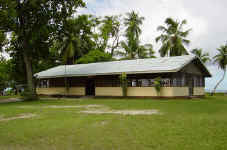
Sant
sosyal
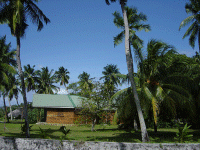
the manager's house
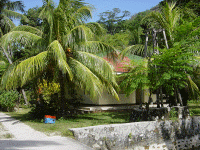
the guesthouse
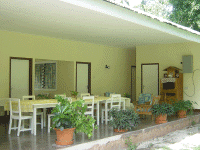
the guesthouse dining-room
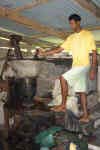 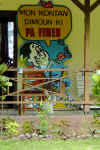
Antoine at the mill and the warning at the
hospital.
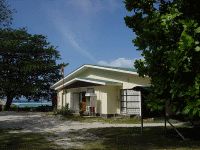
the managers office with the only telephone- box
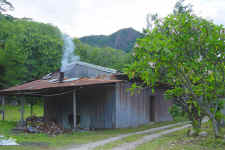
The coconut oven
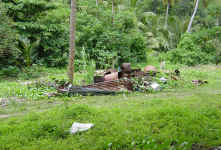
The dump
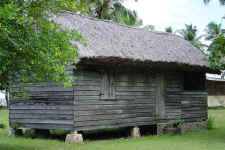
An
example how the houses were till 10 years ago. This is the house of Paul Ali the last boy to make work the fan from the Daubans.
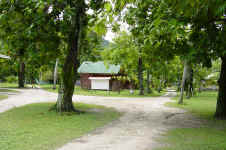
The split to Jamaica.
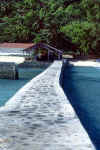 The
jetty before the harbour was built.
|
Let’s
have a walk through La Passe. Leaving the hotel we cross the bridge over the
marsh, which is a breeding spot for a lot of fishes. The water is brackish, and
is fed by the small “Grande Rivière” river as well as by the sea when at
high tide the waves brake over the beach. Walking south we pass the heliport,
and the first building on our left side is the “diving centre”, on the right
side of the path, are two similar houses, one from the hotel owner, the Lapolla
family, and the other for the hotel manager. After about hundred meters on the
left side is the “day care centre”, and next to it the “hospital”, where
a nurse watches over the health from the Silhouetteois. 8 beds are available, 4
for women and 4 for men. But in case of emergency the sick are flown over by
helicopter to Victoria hospital. Remark the colourful warning against smoking in
Creole outside the hospital. Here the path splits, to the right the path leads
to “Jamaica”, and you can hear the noise of one of the two generators,
making electricity 24 hours a day. Continuing south on our left we meet an old
house with a thatched roof, showing how all the houses were before on
Silhouette. This is the house where Paul Ali lived, the man who, when he was a
young boy, was the last to pull the rope for the Dauban’s fan. Next to it, the
social centre, “Sant Sosyal” Creole for the French: centre social. Here
festivities are organized a few times a year, like the 1st of May
for instance at Labour Day. Across the path, on your right side there is the
shop. A nice building, open only 3 days a week. As big the building is, as
little is available in the shop. A South African journalist once said: “The
only store on Silhouette has a range that would make a soviet-era supermarket
seem like the Harrod’s food hall”.
When
we cross the bridge, on our right side we have the “guest house”, consisting
of 4 bedrooms, showers and toilets, a kitchen and a dining room. Only for local
needs or scientist. Opposite is the nice house for the island manager. Except
two small henhouses, on our right side in the back, we have “Gran Case” in
front of us…. . In the meantime we see the new harbour built in 2000. In fact,
too big for small boats, and too small for big boats. The picturesque little
jetty, built 140 years earlier by Auguste Dauban, is now a part of the harbour
and can still be seen on the south end of it. The building at the entry of the
harbour is the storage, housing the manager’s office. In front you find the
only telephone box of the island. On the left side of the Grand Case on the
hillside 24 steps high there is the old hospital which was in use till 1984 (you
had to be in good shape to reach it).
Behind the storage we find and empty house made of corrugated iron, with on the
other side of the path, a building in the same material. Here the coconuts are
taken out of their hull, and afterwards by burning the shells the nuts are
dried, what makes it easier to take out the coconut meat. Most of the time the
copra is transported to Mahé, but formerly, the coconut oil was won by a
press, which still stands in the two smaller neighbouring buildings, nowadays
only used from time to time. On the left side of the path is a concrete plateau
where until 1997 the heliport was. Now we are at the last house of La Passe,
but not less important,
Ron Gerlach’s house, the seat of “Nature Protection Trust of
Seychelles”. When nobody is around, just ring the bells on the font-door, and
he or his lovely wife Gill will be very glad to give you all the information
about NPTS, as well as to show the giant tortoises, and the terrapin project.
You will always be welcome in the information centre were more detailed
information can be given, and souvenirs can be bought to support the
organisation.
The path continues to the mauseleum and the beaches Anse Lascar and
Anse Patat. When you return north at the split near the hospital,
the path left leads to Jamaica, in fact a part of La Passe. Entering Jamaica on
your right side you have the church, where every Sunday a service is held at 9
o’clock. The village consists of 12 houses, and leaving the village you turn
to the right and cross a bridge, where the school is, and children can study
till the age of twelve, the next years they have to go to school on Mahé.
Following the small football field you arrive at the North side of the hotel.
If instead of going right to the hotel, you turn left, you first see several
houses on piles, where before the workers of the chicken farm were living, now
occupied by local people, and you also see the old chicken farm, built in the
late eighties, and closed in 1996. Here thousands of chickens and a few pigs
and cows were held. Some say, because there were to many complaints from the
hotel, especially with the North West Monsoon, when the wind blew all the smell
to the hotel. Others say that it did not pay, seen the costs and the
difficulties of transport for the food as well as for the chicken. In this
period there wasn’t a harbour yet, and it was cheaper to import frozen
chicken from Denmark. For the moment it is useless, and something should be
done. Now, the garbage is dumped here. An advantage is, a hundred of papaya trees grow on this
refuse dump.
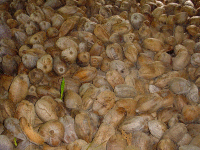 |
